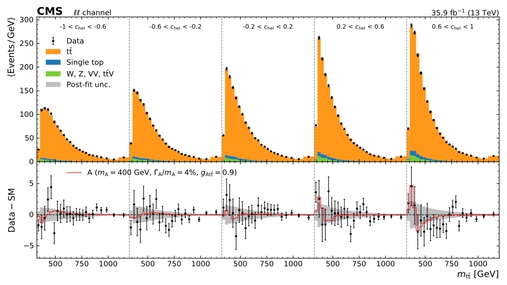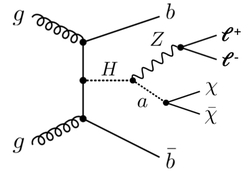Heavy Higgs Searches
Searches for Heavy Higgs Bosons
Compact Muon Solenoid Experiment
Searches for Heavy Higgs Bosons
Searches for heavy scalar and pseudoscalar particles decaying in top quark pairs
The Higgs boson with a mass of about 125 GeV is the latest elementary particle discovered at the LHC. Understanding whether it is the only scalar particle or not is one of the most interesting questions in fundamental science today.

Figure 1: Example graph for heavy scalar or pseudoscalar Higgs production decaying into a top quark pair in dilepton final states.
Searching for new heavy Higgs bosons is particularly exciting, as they could be the missing link between the Standard Model (SM) and dark matter. Since Higgs bosons interact more strongly with particles of higher masses, decay channels involving top quarks – the heaviest particles in the SM – are dominant when the scalars are sufficiently massive.
The The DESY Exotics group performed the search for heavy Higgs bosons decaying into top quark pairs, using 36 fb-1 of data in the channel where both top and antitop quark decay leptonically, leading to two charged leptons in the final state. The search considers pseudoscalar or scalar states, denoted A and 𝞍, respectively [1].
In the analysis, both the invariant tt mass distribution and the spin correlation helicity angle were investigated. The search covered A or H boson masses between 400 and 750 GeV and a total relative width from 0.5 to 25% relative to the mass. Figure 2 shows the tt mass distribution for five different bins of the angular distribution. The data is compared to the SM prediction (upper row). The difference between the data and the SM prediction is shown in the lower row. For illustration, we added the contribution from the presence of an A boson at 400 GeV and a relative width of 5% (red histogram).

Figure 2: Invariant-mass distribution of the top-quark pair for five different intervals of the tt spin correlation helicity angle

Figure 3: Constraints on the coupling strength between the pseudoscalar boson and the top quark as a function of pseudoscalar mass, assuming a total relative width of 5%. The limit expected in the SM (dashed curve) including uncertainties at the 68% (95%) confidence level indicated by the green (yellow+green) band are compared to the observed limit in data (blue shaded area). The unphysical region of phase space from considerations of the total A boson width are added (grey hatched line).
Constraints were set on the coupling strength between the A or 𝞍 bosons, respectively, and the top quark. Figure 3 shows upper limits on the Att coupling strength as a function of the A boson mass for the case of 5% total relative width, combining dilepton and single-lepton final states. The observed constraint is weaker than the expected limit around an A boson mass of 400 GeV. This corresponds to the deviation observed between the data and the SM prediction in the tt mass distribution, particularly at high values of the helicity angle, that is compatible with a pseudoscalar Higgs boson signal with a mass of 400 GeV (Fig. 2). The local significance of the effect was 3.5 standard deviations. However, accounting for the look-elsewhere effect, the significance of the signal-like deviation was 1.9 standard deviations. We therefore concluded that the current data set shows agreement with the SM prediction.
Today:
To find out whether the deviation is a first hint of new physics beyond the SM or not, the full 137 fb-1 of data taken during LHC Run 2 are currently used for an update of this analysis, and new search strategies will be explored. The DESY Exotics group will continue to be at the forefront to stress-test the compatibility between the data and the SM and to find out if the data indeed hint at new phenomena.
Search for the production of a pseudoscalar particle in association with a Z boson and a bottom quark pair
Similarly, we also intend to search for direct DM production in heavy Higgs decays into a leptonically decaying Z boson and a pseudoscalar DM mediator. And example Feynman graph is shown in Figure 4.

Figure 4: Example graph for heavy pseudoscalar Higgs production decaying into Dark Matter particles in association with Z(→ll) bb.
We will be performing this analysis with the full Run-2 dataset. The results will give us an exciting discovery potential for DM. We will also optimize the search with machine learning techniques and contributing to phenomenological investigations associated with it.
This project is foreseen for a Postdoc and a PhD student.
First feasibility studies of this process are foreseen for bachelor and master students.
Reference:
[1] CMS Collaboration, Search for heavy Higgs bosons decaying to a top quark pair in proton-proton collisions at √s = 13 TeV, JHEP 04 (2020) 171, arXiv:1908.01115 [hep-ex], CMS-HIG-17-027.